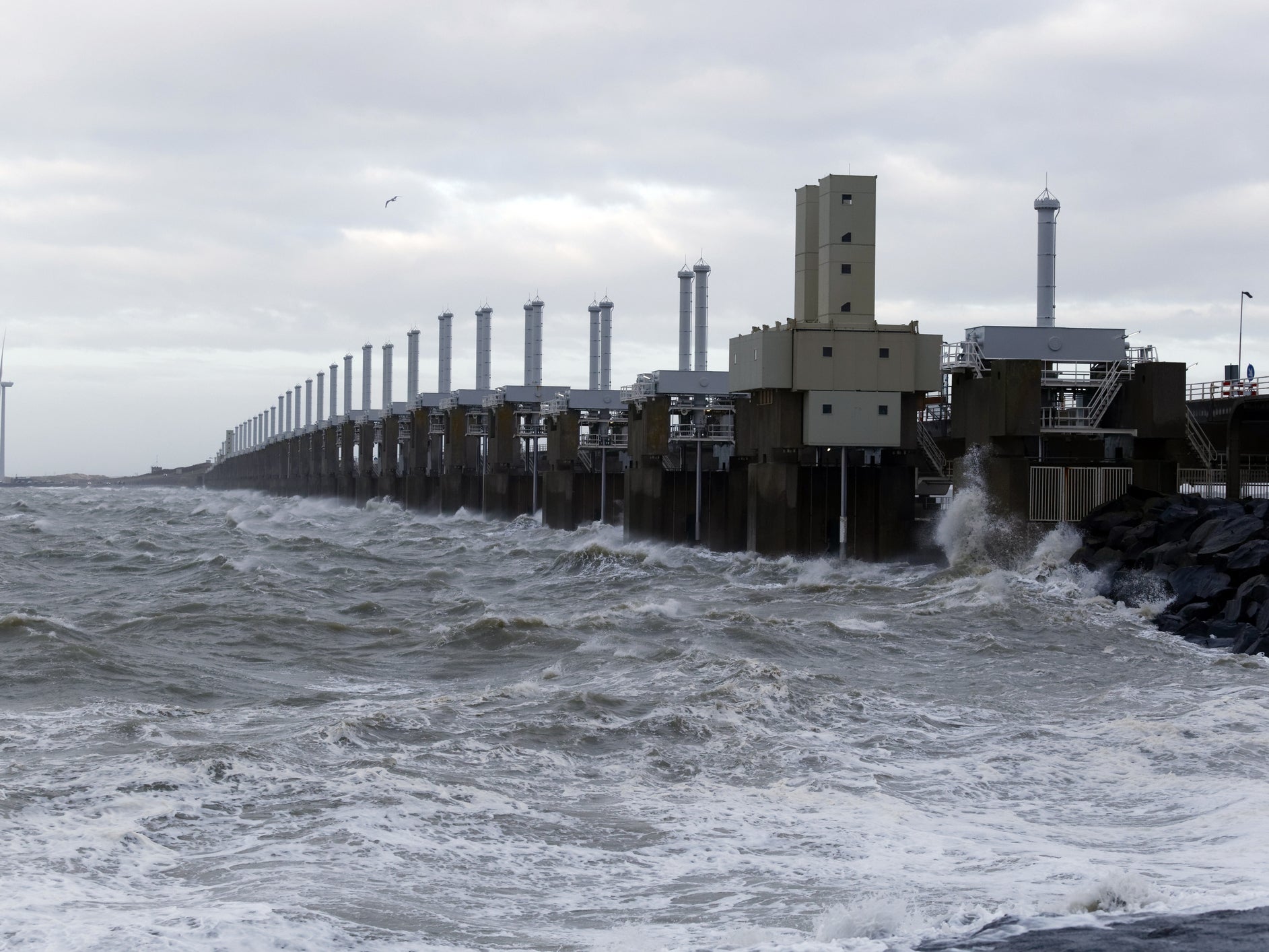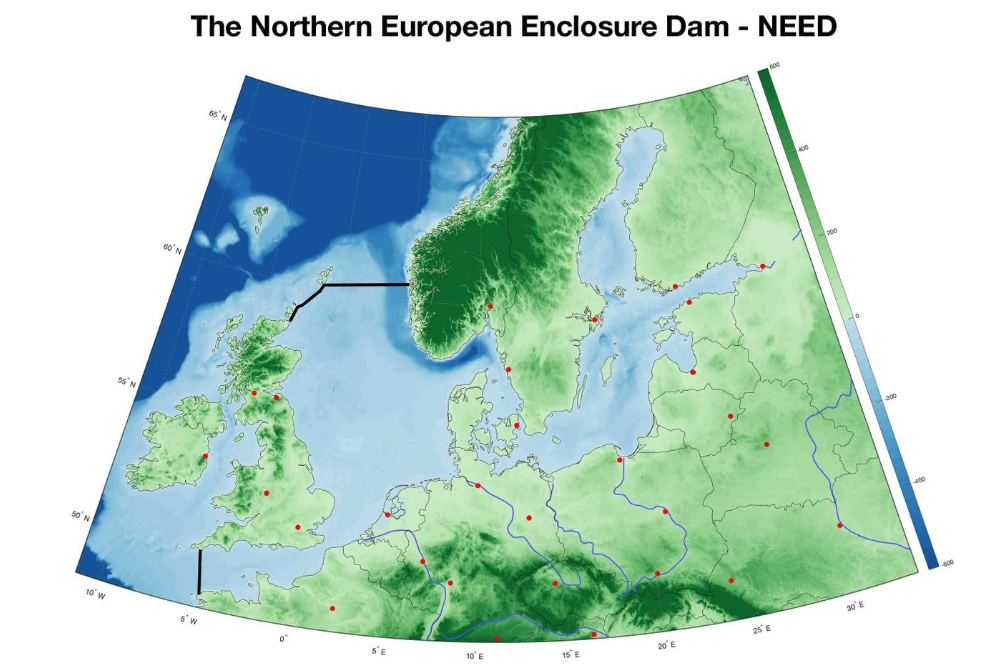Climate crisis: Plan to dam entire North Sea could protect millions from rising oceans
Global failure to tackle emissions may mean ‘extreme’ infrastructure project is needed to save cities from submersion, scientists warn

The floodwaters are coming for us. Sea levels are rising faster and could swell one to two metres in the next 80 years if greenhouse gas emissions are not swiftly reined in, according to the latest research by UN scientists.
It means we are currently on track for many people alive today to see several of the world’s major cities, including London, New York, Shanghai, Los Angeles, largely lost beneath the waves, while the world would lose 1.79 million sq km of land - an area roughly the size of Libya.
In Europe, the Netherlands is particularly at risk, with a third of the country already lying below sea level.
So what can be done?
One mega-infrastructure scheme put up for discussion by a Dutch government scientist suggests addressing the issue in northern Europe by damming in the entire North Sea.
This would require the construction of two dams of unprecedented scale. The smaller of the two would be around 100 miles long and block the entire western end of the English Channel, between Brittany in France and Cornwall in England.
The second dam would be a monster 300 miles long, and would cross the top of the North Sea between Scotland, running south of the Shetland and Orkney islands, and all the way over to Norway.
The plan would also mean the Baltic Sea would lose direct access to the rest of the world’s oceans.
The result would ultimately be the creation of an enormous lake to the south and east of Britain, around western Norway, north France, and would represent the entire coastlines of Denmark, Sweden, Finland, Estonia, Latvia, Lithuania, Poland, the Netherlands and Germany.

The scientists predict the successful completion of the project could protect 25 million Europeans against sea level rise in the coming centuries.
They estimate it would cost €250-500bn (£210-420bn), or “merely” 0.1 per cent of the gross national product of all the countries that would be protected. In comparison, the UK’s HS2 rail project is costing £106bn.
“The construction of such a ‘North-European Enclosure Dam’ seems to be technically feasible,” said Dr Sjoerd Groeskamp, an oceanographer at the Royal Netherlands Institute for Sea Research (NIOZ).
“The maximum depth of the North Sea between France and England is scarcely one hundred metres. The average depth between Scotland and Norway is 127 metres, with a maximum of 321 metres just off the coast of Norway. We are currently able to build fixed platforms in depths exceeding 500 metres, so such a dam seems feasible too,” he said.
The authors acknowledge the consequences of this dam for North Sea wildlife would be catastrophic.
“The tide would disappear in a large part of the North Sea, and with it the transport of silt and nutrients. The sea would eventually even become a freshwater lake. That will drastically change the ecosystem and therefore have an impact on the fishing industry as well,” Dr Groeskamp said.
Together with his German colleague Joakim Kjellson at the Helmholtz Centre for Ocean Research Kiel (GEOMAR), they calculated the financial costs of the project by studying large dams built in South Korea.
They said their calculations took into account economic factors such as the loss of income from North Sea fishing, increased costs for shipping across the North Sea and the costs of massive pumps which would be required to transport all the river water that currently flows into the North Sea to be emptied on the other side of the dam.
Their research is to be published this month in the scientific journal of the American Meteorological Society.
But despite addressing the practicalities of such a colossal project, the authors said their proposal should be interpreted as “more of a warning than a solution”.
Dr Groeskamp said: “The costs and the consequences of such a dam are huge indeed. However, we have calculated that the cost of doing nothing against sea level rise will ultimately be many times higher.
“This dam makes it almost tangible what the consequences of the sea level rise will be; a sea level rise of 10 metres by the year 2500 according to the bleakest scenarios.
“This dam is therefore mainly a call to do something about climate change now. If we do nothing, then this extreme dam might just be the only solution.”
Sea level rise is caused by two factors related to global warming. The accelerating melting of ice sheets and glaciers is pouring water into the oceans, which rise further because of the expansion of seawater as it warms.
Worryingly, even if greenhouse gas emissions are significantly reduced, it may already be too late for many cities.
Dutch meteorological agency, the KNMI, has calculated sea levels could rise two metres by 2100 even if the Paris targets are met, but by three metres if they are not.
The suggestion of a massive dam for the North Sea comes days after a similar scheme was proposed to protect New York.
A $120bn (£92bn), six -mile-long sea wall is the biggest project under apparently consideration by the Army Corps of Engineers, who are examining plans designed to protect the city as damaging storms become more frequent due to climate breakdown.
The plan has sparked fierce debate as to how best preserve the city, and the offshore sea wall already has its notable detractors.
Donald Trump tweeted on 18 January: “A massive 200 Billion Dollar Sea Wall, built around New York to protect it from rare storms, is a costly, foolish & environmentally unfriendly idea that, when needed, probably won’t work anyway. It will also look terrible. Sorry, you’ll just have to get your mops & buckets ready!”
Join our commenting forum
Join thought-provoking conversations, follow other Independent readers and see their replies
Comments